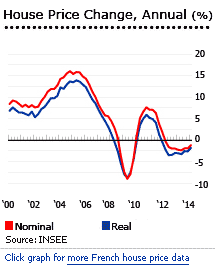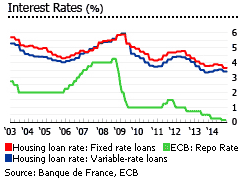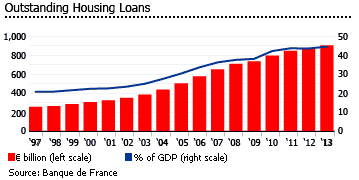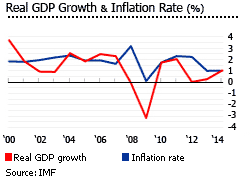Further house price declines in France, as economy's agony continues
 House prices in Metropolitan France fell for the ninth consecutive quarter, falling by 1.21% during the year to Q2 2014, according to the National Institute for Statistical and Economic Studies (INSEE), or 1.83% y-o-y when adjusted for inflation. On a quarterly basis (i.e. q-o-q), house prices in Metropolitan France remained the same.
House prices in Metropolitan France fell for the ninth consecutive quarter, falling by 1.21% during the year to Q2 2014, according to the National Institute for Statistical and Economic Studies (INSEE), or 1.83% y-o-y when adjusted for inflation. On a quarterly basis (i.e. q-o-q), house prices in Metropolitan France remained the same.
Prices continue to fall in Paris, with apartment prices declining by 1.22% (-1.84% inflation-adjusted) during the year to Q2 2014, falling to €8,120 (US$ 10,269) per square metre (sq. m.), the fifth consecutive quarterly price drop, according to La Chambre des Notaires de Paris.
- In Ile-de-France, the wealthiest and the most populated region in France, the average apartment price fell by 1.47% y-o-y (-2.08% inflation-adjusted) to €5,380 (US$ 6,804) per sq. m. in Q2 2014.
- In the Petite Couronne (Small Crown), the average price of apartments fell by 1.36% y-o-y (-1.98% inflation-adjusted) to €4,340 (US$ 5,488) per sq. m.
- In the Grande Couronne (Great Crown), the average price of apartments dropped by 2.28% y-o-y (-2.89% inflation-adjusted) to €3,000 (US$ 3,794) per sq. m.
Sales rising, pushed by low interest rates
However sales transactions improved in the first half of 2014, so things may be looking up for French property market. Interest rates are at an all-time low:
- The average rate on new housing loans with initial rate of fixation (IRF) of more than a year was 2.89% in August 2014, down from 3.13% a year earlier.
- Interest rates on loans with IRF of one year or less also fell to 2.62%, down from 2.65% in August 2013.

“These are now officially the lowest rates we have seen for French mortgages this century or last,” says John Busby of French Private Finance. "A 20 year fixed rate mortgage in France hit 3.10%, and 25 year fixes for 80% of the purchase price were available from 3.50% for non-resident buyers this week, as the TEC 10 index tumbled to a new all-time low of 1.22%."
In September 2014, the ECB announced another key interest rate cut, reaching a new historical low of 0.05%, due to the euro zone’s ailing economy (euro zone growth is projected to be 0.9% in 2014) and low inflation (projected to be 0.6% in 2014). Aside from the rate cut, the ECB also announced new stimulus measures including an asset purchase programme, which aims to buy debt products from banks.
This was the second rate cut this year, and the ECB’s 7th rate cut since end-2011. Three months earlier, the central bank cut its rate from 0.25% to 0.15%, and introduced negative interest rates as well.
The number of existing homes sold in France over the 12 months rose by almost 8% to 732,000 units from the same period last year, according to the Conseil général de I´environnement et du développement durable(CGEDD).
New lending rose in France by 2.8% from the previous year, according to the European Mortgage Federation (EMF). Lending by credit institutions to households increased by 2.89% during the month of August 2014, slightly higher as the same month last year’s growth of 2.87%, and still below from the 15.9% peak rise in October 2006.
Based on the latest European Central Bank’s (ECB) bank lending survey, credit standards for housing loans to households in France remained unchanged in Q2 2014.
Paris is doing well
Paris itself, i.e.., the centre of the Paris region, is gaining over its periphery: existing apartment sales in Paris rose 12% y-o-y to Q2 2014, according to La Chambre des Notaires de Paris. Further out, both the Ile-de-France and Grande Couronne had only a slight apartment sales increase of 1% y-o-y over the same period, while in Petite Couronne apartment sales actually fell by 7% y-o-y. Traffic congestion is becoming an increasing issue in Paris, possibly contributing to the re-valuation of the centre. The volume of house sales in Ile-de-France however rose by 5% during the year to Q2 2014, and an increase in home sales was also observed in Grande Couronne (6%) and Petite Couronne (2%).
During the housing boom from 1997 to 2007, French house prices surged by 150% (112.5% inflation-adjusted).
The housing market started to weaken in 2008, but price-falls have been very moderate in France:
- In 2008, house prices in France fell by 3.82% (-5.49% inflation-adjusted)
- In 2009, house prices fell by 4.17% (-4.52% inflation-adjusted)
- In 2010, house prices rose by 7.59% (5.85% inflation-adjusted).
- In 2011, house prices rose by 3.76% (1.29% inflation-adjusted)
- In 2012, house prices fell by 1.99% (-3.48% inflation-adjusted)
- In 2013, house prices fell by 1.94% (-2.57% inflation-adjusted).
Property prices in France are expected to drop by 4% in 2014, forecasts Standard and Poor’s (S&P), but to rise by 1% and 2% in 2015 and 2016, respectively.
French house-buyers can now track house price changes week-by-week, following the launch in September of the LPI (Les Prix de l’Immobilier) index. The LPI shows weekly house price changes, using data from sources such as banks and financial institutions including Sogeprom, Gecina, Crédit Foncier, as well as from Syndicat National des Professionels Immobiliers (SNPI), the national syndicate for real estate prices.
Newbuilds at new low, due partly to new rent control law
House prices will be supported by a fall in new builds.
French construction has fallen to its lowest for more than 15 years, worsened by a new rental law capping rents in expensive areas (such as Paris).
- New housing starts fell by 13.2% to 188,862 units during the year to August 2014.
- Total authorized dwellings fell by 13.1% to 255,839 units.
- The number of house permits issued in France in 2013 fell by 12.6% y-o-y to 432,885 units, according to the Ministère de l’Écologie, du Développement Durable et de l´Énergie.
The Global Property Guide has long been firmly against rent controls, which harm tenants and landlords alike. "It is the surest way to destroy a city without bombing it" noted our former chief economist Prince Cruz in The pros and cons of rent control.
Rental yields low, also partly due to rent controls
The development of France’s rental market is constrained by rent controls. Initial rents are freely determined, but can be revised only once a year, and not by more than the (new) INSEE rental index.
Apartment prices in France rose by 141.37% (187% in Paris) from 2000 to 2013. The increase was higher than the rise of the country’s rent index during the same period, at around 36%, partly because the allowable rent increase has been lower than inflation in certain periods.
As a result, rental yields, especially in Paris, have been disappointing. Based on the Global Property Guide research in July 2013, yields in Paris range from 3.39% to 3.67%, with smaller units getting higher yields than larger ones. France’s rent index rose by only 0.6% during the year to Q2 2014.
In February 2014, the French Parliament passed the loi Accès au logement et un urbanisme rénové (ALUR: improving access to housing and updating town planning), also known as the ‘Loi Duflot’, named after housing minister Cécile Duflot. The bill, which was enacted in March 24, 2014, set new rules regarding housing and property rentals:
- One of the most relevant parts of the law was the rent cap on long-term rentals. It is indicated that rents should not be higher than 20% above the median rent set by the Prefect in the urban areas. This new rent control, which will be imposed on 28 cities with more than 500,000 inhabitants, would affect areas with high demand on rental properties such as Paris, which is expected to see monthly rent declines from 20% to 25%.
- Short-term rentals still need to seek authorization from the City of Paris, or the local town hall in areas with housing shortages.
- Property owners are required to grant exclusivity to one letting or property agent.
- A new mechanism for the Universal Guarantee of Rents (GUL) was introduced; tenants will no longer provide guarantors or pay a deposit, since the government will underwrite any non-payment of rent.
As of 2013, around 57.8% of France’s housing stock belongs to owner-occupiers, which means that almost half France’s population are renting. Of primary residences, around 21.8% are privately rented, while 17.3% are socially rented.
Around 97% of French private rented dwellings have private individual landlords, while only 3% are owned by companies or institutions, according to Dr. Joris Hoekstra, researcher at OTB (TU Delft).
Mortgage market activity recovers
Due to the dominance of fixed rate mortgages, France’s housing market is arguably less prone to sharp upturns and downturns than many others. Fixed-rate loans made up 92.8% of new loans in 2013, and 83.2% of all outstanding loans. In contrast, floating-rate loans only make up 6% of new loans, and around 15.6% of outstanding housing loans, according to the Autorité de contrôle prudentiel et de résolution (ACPR).

Over 80% of all owner-occupied dwellings in France are bought with mortgages. During the last decade the mortgage market has grown enormously, from 22% of GDP in 2000, to 44.6% of GDP in 2013.
In 2013, France’s mortgage market grew by 3.76%, slightly above the 3.20% recorded in 2012. In contrast to declining property prices, the average loan amount continued to increase in 2013 to €142,264 (US$ 179,793). Most mortgages were obtained by owner-buyers, who took 49.2% of outstanding housing loans, followed by first-time buyers at 21.9%.
APCR notes that “persistently difficult macroeconomic conditions should encourage French banks to keep a close watch on the development of risks within their housing loan portfolios”.
Slower economic growth by end of 2014

France´s meagre 0.1% y-o-y GDP growth in Q2 2014 was the lowest since Q1 2013, according to the National Institute for Statistical and Economic Studies (INSEE). On a quarterly basis, France’s economy remained flat for the second consecutive quarter.
The pain continues. The French economy recorded no growth in 2012, as firms slashed thousands of jobs and President Francois Hollande squeezed the budget deficit. In 2013, real GDP growth was estimated at a meagre 0.1%. “This is obviously not enough,” said French Finance Minister Pierre Moscovici.
In May 2012 Francois Hollande became the country’s first Socialist president since Francois Mitterand (1981-1995), In August 2014, France entered political turmoil triggered by Economy Minister Arnaud Montebourg´s demand for an end austerity policies. Montebourg demanded a fiscal stimulus to boost growth, arguing that France shouldn’t be “slavish” and “dogmatic” in pursuing deficit cuts.
Although President Hollande has an all-time low approval rating of 17%, he asked Manuel Valls, Prime Minister since March 2014, to form a new government “consistent with the direction set for the country”. In the new French cabinet Montebourg was replaced as Economy Minister by Emmanuel Macron, a former investment banker at Rothschild. Michel Sapin, a career politician, was appointed Finance Minister, all of which signals a determination to continue France´s present austerity policies.
From 2004 to 2007, the French economy expanded by an average 2.3% per year. However, the economy contracted by 0.08% in 2008, and declined again by another 3.1% in 2009, France’s sharpest recession since World War II. Despite the worsening eurozone debt crisis, the French economy managed to expand by 1.7% in 2010 and by another 2% in 2011.
Due to the first two quarters´ disappointing figures, Finance Minister Sapin reduced the government’s growth forecast for 2014 to 0.5%, from the previous estimate of 1%. In 2015, economic growth is expected to be around 1%.
INSEE has noted that business confidence levels in France are even lower than in Spain or Germany. France’s expected growth in 2014 is only half of the bloc’s economic forecast of around 0.8%.
Aside from low growth in 2014, INSEE also expects unemployment to be 10.3% by the end of 2014. High unemployment is one of France’s major problems. As of July 2014, unemployment rate was 10.5%, up from 10.2% in July 2013, one of the highest increases in the eurozone.
In August 2014, annual inflation eased to 0.4%, well below the 0.9% inflation recorded in the same month last year.
Public debt is expected to hit a record 95.1% of GDP this year, up dramatically from 85.8% of GDP in 2011, and far higher than previous estimates. France’s public deficit reached 4.1% of GDP in 2013, down from 4.8% of GDP in 2012 but higher than its EU-agreed target for 2013. The government aims for a 3.6% of GDP deficit this year, by tightening spending of local authorities and ministries. About €15 billion is expected to be saved this year through austerity measures.